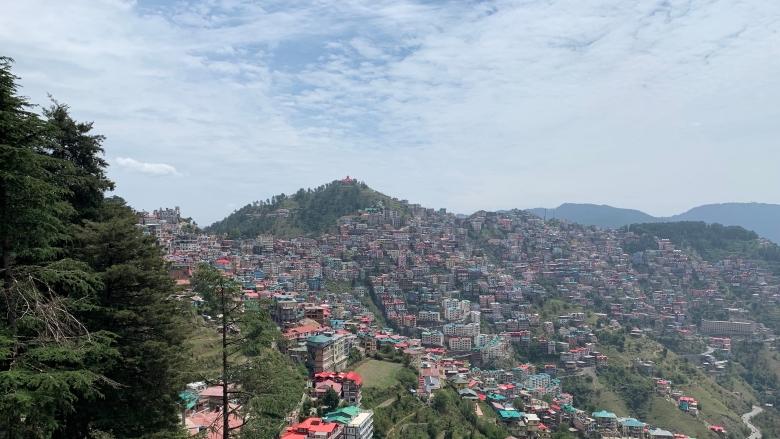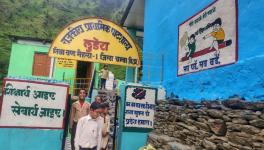Workers Hit Hardest as Existential Crisis Grips Tourism Sector in HP

Most of the big hotels in Shimla and in Himachal Pradesh have started laying-off their workforce; the medium-sized and smaller ones had done the same a few weeks after the first phase of the lockdown began. The major hotels that have started laying off their workers include Marina, Combermere, Landmark, Rajdoot, East Bourne, Shere-e-Punjab, Himland West and almost a dozen others. Meanwhile, the government has not intervened to either provide relief to the workers or the hospitality industry itself, so that it could ensure that their wages could be taken care of.
The Hotel and Restaurants Association met the state government on a number of occasions and asked for support of Rs 3,000 per month per worker. An equal amount was supposed to be provided by the hotel and restaurant owners. However, the government did not shell out even a single paisa to either the association, or to the workers.
Himachal Pradesh has 3,679 hotels and 2,189 ‘home-stay’ units registered with the state tourism department. It is estimated that almost 50% more home-stays function under the B & B (bed and breakfast) category and various other international and national chains are not registered with the state government.
The tourism sector contributes about 7% to the state’s GDP. The total inflow of tourists had jumped from 6.55 million in 2004, to 17.21 million people in 2019(the state’s population is about 6.8 million). Nearly 10% of the jobs in the state are due to either the tourism sector or other related activities like sightseeing, camping, trekking etc. All of this is ruined for the moment.
The All Himachal Associations of Hospitality and Tourism Forum, which comprises 18 associations of hotels, restaurants and travel agents, met the state government several times and asked for its support for the fixed expenditure. Instead of being sensitive to their demands, the government behaved in an offensive manner and one of the senior cabinet ministers even said, “You have earned for so many years, what (is the harm) if you have to shed some money in this period?” The government has blatantly refused to help the hospitality industry in the state.
An alternative, suggested by the Chief Minister, which became the subject of much ridicule, was “destination quarantine”. The CM was criticised for the idea, which was later given up. Destination quarantine would mean that the state, which has relatively lesser number of COVID-19 patients, would be flooded with people. For the Bharatiya Janata Party state government, this was an opportunity, as the Prime Minister has said on numerous occasions, rather than a period of crisis, to save lives.
Tourism happens to be one of the most affected sectors worldwide. According to a report, 96% of tourism destinations worldwide have introduced restrictions, or are completely shut. In Africa, Asia Pacific and West Asia, all tourism destinations are either shut or restricted for tourists. According to the World Travel and Tourism Council, up to 50 million jobs worldwide and 30 million jobs in Asia could be lost in the travel and tourism industry. Asia will be the worst-affected, owing to various other reasons. It is estimated that even when the outbreak is over, it would take another 10 to12 months for the industry to recover. This means the tourism industry shall be back on its feet by early 2022. What happens to the large number of people that it employs? There are no answers at the moment!
The tourism industry accounts for just over 10% of the world’s GDP. There has already been a loss of between 850 million and 1.1 billion international tourists, and a revenue loss of between $90 billion and $1.2 trillion in export revenues from the tourism sector. Nearly 100 to 120 million jobs are at risk across the world.
The Indian story is no different, aside from the fact that some of the developed nations did support the sector by sharing their wage bill. However, in India, nothing of the sort has happened. The only form of help rendered in India is to provide loans which the industry is not prepared to accept, owing to a bleak future, at least in the coming months.
The national federation of 10 tourism and hospitality organisations in India estimates an overall revenue loss of Rs 5 trillion (Rs 5 lakh crore), and job cuts for between four to five crore people. The CII (Confederation of Indian Industries) estimates a loss of Rs 1.58 lakh crore for the organised sector in the tourism industry. It has further categorised the estimated loss; it said that the branded hotel groups are set to lose Rs 1.10 lakh crore, online travel agencies Rs 4,312 crore, tour operators Rs 25,000 crore, adventure tour operators Rs 19,000 crore and cruise tourism will lose about Rs 419 crore.
Between April and June, the tourism industry is estimated to have incurred a loss of Rs 69,400 crore. Foreign tourist arrivals (FTAs) were 10.9 million, and foreign exchange earnings (FEE) were Rs 2,10,971 crore in 2019, with Uttar Pradesh, Delhi, Maharashtra and Tamil Nadu accounting for 60% of foreign tourist arrivals. The number has been negligible since March and there are no signs of revival for at least another few months.
Nearly 80% of the tourism industry in India falls under the MSME (micro, small and medium enterprises) category. The Finance Minister’s stimulus package did not even reach out to this important sector. Though the Ministry of Tourism has said that the government is considering providing the sector with soft loans, a working capital and deferment on loan payments – no respite has been given to the industry yet. Above all, the industry does not require loans, it is already under huge debt, and it rather requires a stimulus and a corpus fund to ensure that people can survive, at least.
One of the chief executive officers of the Federations of Associations of Tourism and Hospitality (FAITH) had recommended a salary corpus for this sector. For example, had the government agreed to provide a mere Rs 3,000 per worker as a salary corpus for the tourism industry in Himachal Pradesh. It would have cost the exchequer not more than Rs 20 crore for a period of three months. However, governments, both at the Centre and in the state, are not prepared to provide this help, thus ruining the livelihoods of the people engaged in this industry.
As a result, the hotel industry is adopting the method of laying-off its workers. The government, instead of proactively intervening in this sector, has left it to the owners of the hotels and the restaurants and the workers unions, who have started holding protest demonstrations outside some of the hotels, calling it illegal retrenchment.
The writer is former Deputy Mayor of Shimla. The views are personal.
Get the latest reports & analysis with people's perspective on Protests, movements & deep analytical videos, discussions of the current affairs in your Telegram app. Subscribe to NewsClick's Telegram channel & get Real-Time updates on stories, as they get published on our website.
























